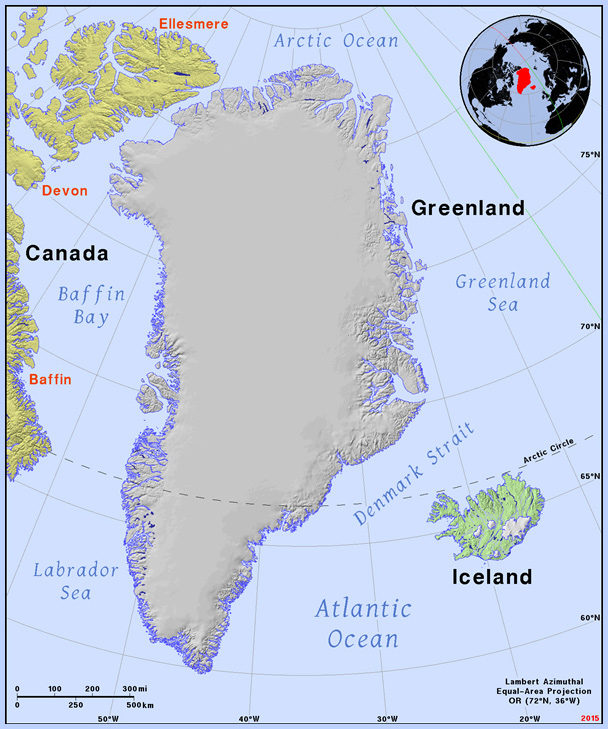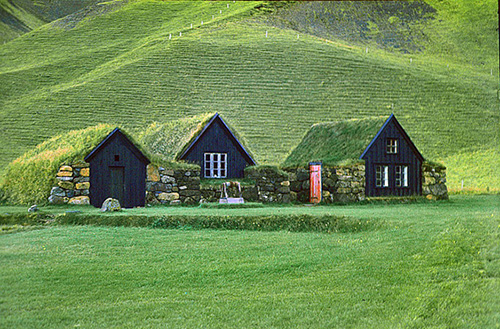
If you’ve been to Iceland, you know it doesn’t have much ice. In fact, there’s so much grass that on maps it’s colored green.
On the other hand, you probably know that Greenland is covered in glaciers. So why is the green one Iceland and the white one Greenland?
Legend has it that the Vikings who discovered Iceland wanted to protect it from settlement, so gave it an unflattering name.
But it was actually a matter of perspective. The first explorer to Iceland had a terrible trip. His daughter died on the long voyage. He arrived in winter and his livestock froze. That spring, his ship was nearly sunk by icebergs.
Fed up, he called it as he saw it: Iceland. And the name stuck.
A century later, another Viking explorer was visiting Iceland when he got in a fight with the settlers and was run off the island.
He sailed west and found Greenland, which was warmer than today, and the coastal areas were indeed green. Wanting to attract settlers, he called it Greenland.
They came, and built farms and grazing operations—which lasted until around 1400, when the climate cooled.
Greenland’s glaciers expanded, leaving less green land.
Today the Arctic is warming, which means Greenland’s glaciers are melting, and it may one day be greener again.
Conversely, cold glacial meltwater entering the ocean from Greenland could blunt the Gulf Stream that warms Iceland, making it icier.
Background
Synopsis: Although they are at similar latitudes, for most of the year Iceland is covered in luscious green vegetation, while Greenland is covered with glaciers that are as much as 130,000 years old. Iceland actually imports 40 percent of its ice from other countries.
- Greenland is the least populated territory on the globe. It is more than three times the size of Texas and more than 20 times as large as Iceland (which is about the size of Kentucky), but Iceland has about 6 times as many people as Greenland.
- The southernmost point of Greenland extends 3 degrees (207 mi, 333 km) farther south than the southern shore of Iceland.
- More than 80 percent of Greenland is glaciated with three distinct phases of ice- sheet formation, which started around 130,000 years ago.
- Only 10 percent of Iceland is covered by permanent ice. The Gulf Stream creates a milder climate in Iceland, extending northward and causing sea-surface temperatures around the island to be about 10oF (6oC) warmer than those around Greenland.
- Because Iceland is so remote and must rely on imports of many products, it is a very expensive place to live and work. High labor costs mean anything manufactured in Iceland is very expensive.
- With North Atlantic treaties providing favorable tax treatment for Iceland’s abundant imports, it is actually less expensive for Iceland to import ice from Norway, Britain, and the United States than to make it on the island!
- Viking explorers tended to descriptively name the lands they discovered. Why, then, did they call the verdant island along the Mid-Atlantic Ridge Iceland and the glacial island to its northwest Greenland? It all depended on their point of view!
- Some say Vikings chose the name Iceland to discourage oversettlement; however, historic records suggest a sadder origin for the name.

Traditional Icelandic turf houses. Until the twentieth century, most Icelanders lived in rural areas. And a fun fact: Many scenes from Game of Thrones were filmed in Iceland. Credit: Wikimedia (public domain) - In the late A.D. 800s, a Viking explorer called Flóki Vilgerðarson described the land from the perspective of his horrific wintery expedition. His daughter died on the voyage to the island; then, having arrived unprepared for winter, his livestock froze to death. A fjord filled with icebergs (likely calved from Greenland’s glaciers) was the last straw, prompting him to name the island Iceland.
- Flóki recommended that no settlement should occur on the island, but a crewmember with fonder memories of their arrival described it as a garden isle, and settlement started soon thereafter.
- About a century later, in the summer of A.D. 982, Leif Eríksson’s father Erik the Red was chased away from Iceland after killing three people in a feud. He sailed west and landed in southwestern Greenland.
- Data from both ice cores and mollusk shells suggest that southern Greenland was warmer—and probably greener—from A.D. 800 to 1300, cooling down to present temperatures in the 1400s.
- When Erik the Red arrived, broad grasslands invited sheep herding and potato farms, which still exist today along the coast. He named the country Greenland reckoning that people would be more prone to settle in a country with an encouraging name.
- Native Inuit Greenlanders call their country Kalaallit Nunaat, which simply means “Land of the People” in their language.
- Some say Vikings chose the name Iceland to discourage oversettlement; however, historic records suggest a sadder origin for the name.
- The Arctic is currently one of the fastest-warming places on the planet, which may have ironic consequences.
- As the Greenland ice sheet melts, the island is greening; however, icebergs and very cold fresh glacial outflow water floating on the surface of the Atlantic may significantly inhibit the northward extent of the Gulf Stream.
- A weaker Gulf Stream would result in much colder temperatures and the likely development of sea ice in Iceland, fulfilling the centuries-old omen of Flóki’s name for the country.

